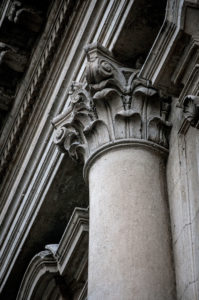The city, hit by the earthquake, was rebuilt in the same place, maintaining the previous urban plan and inserting beautiful new buildings in Baroque style.
The city of Caltagirone became an example of urban planning for the other cities affected by the earthquake of 1693. In particular, its plan was adopted in the reconstruction of Catania by the Duke of Camastra. The new buildings within the modern urban layout include the Monte delle Prestanze or Monte di Pietà in the square bordered by the Senatorial Palace, and opposite the church of San Giuliano (St. Julian).

 Built at the start of the 18th century by architect Natale Bonaiuto, the building has a square plan. Its uniqueness manifests in the elevation.
Built at the start of the 18th century by architect Natale Bonaiuto, the building has a square plan. Its uniqueness manifests in the elevation.
In fact, it has a series of giant half columns on tall plinths, i.e. extending from the ground up to the upper floor, arranged in a tight pattern.
The absence of corbels and the thicker columns near the entrance are newer elements than the local tradition.
It was a symbol of great modernity and a very representative style for a building used as a civic bank.